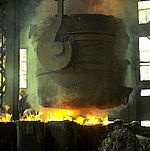
Martensite

Martensite is a very hard form of steel crystalline structure. It is named after the German metallurgist Adolf Martens (1850–1914). By analogy the term can also refer to any crystal structure that is formed by diffusionless transformation. Martensite includes a class of hard minerals that occur as lath- or plate-shaped crystal grains. Martensite is formed in carbon steels by the rapid cooling (quenching) of the austenite form of iron at such a high rate that carbon atoms do not have time to diffuse out of the crystal structure in large enough quantities to form cementite (Fe3C). Austenite is γ-Fe, (gamma-phase iron), a solid solution of iron and alloying elements. As a result of the quenching, the face-centered cubic austenite transforms to a highly strained body-centered tetragonal form called martensite that is supersaturated with carbon. The shear deformations that result produce a large number of dislocations, which is a primary strengthening mechanism of steels. The highest hardness of a pearlitic steel is 400 Brinell whereas martensite can achieve 700 Brinell. The martensitic reaction begins during cooling when the austenite reaches the martensite start temperature (Ms) and the parent austenite becomes mechanically unstable. As the sample is quenched, an increasingly large percentage of the austenite transforms to martensite until the lower transformation temperature Mf is reached, at which time the transformation is completed.
